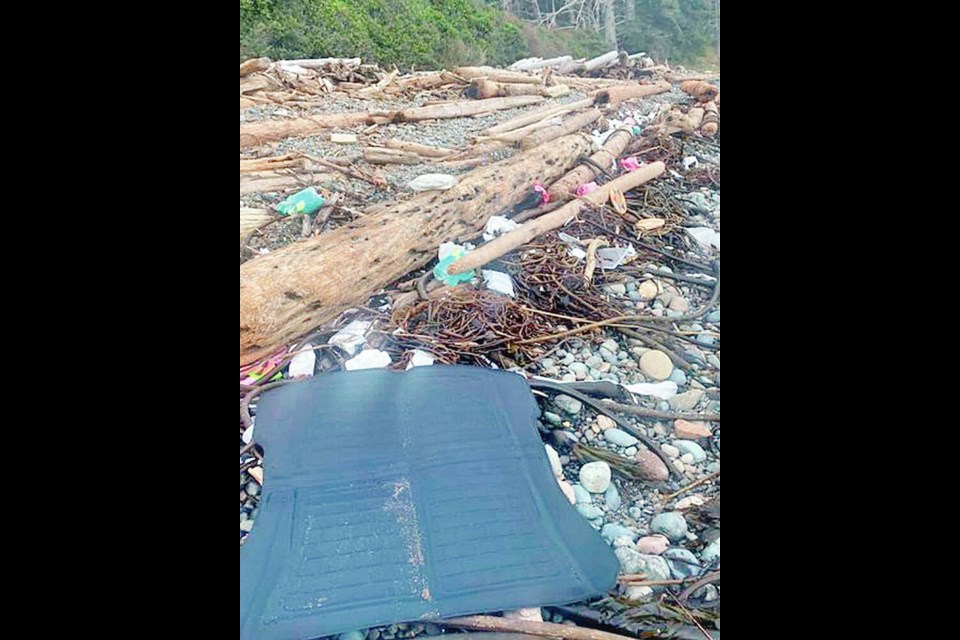Refrigerators, styrofoam chunks, colourful toys and other debris scattered over one of the north Island’s most pristine beaches are believed to be from one of 109 shipping containers that fell into the ocean a week ago.
So far, just four of the 12-metre containers from the 260-metre-long Zim Kingston have been found — three were near Cape Scott and one was seen Thursday afternoon floating off Cape Sutil at the northern tip of Vancouver Island.
Environment Canada’s trajectory modelling shows that any containers still floating will drift north, the coast guard said. Since the containers crashed into the ocean west of Bamfield, some have travelled north about 300 kilometres.
Metal containers are not watertight and the coast guard believes some might have already sunk.
A contractor hired by Greece-based Danaos Shipping, which manages the Zim Kingston, now moored off Victoria at Constance Bank, is preparing to remove the containers that have washed up and has hired an environmental consultant to provide advice.
When Port Hardy educational assistant Jerika McArter arrived at Palmerston Beach, south of Cape Scott, on Wednesday she was shocked to see debris littering the shore and posted photographs on social media.
McArter, who figures the debris originated from the Zim Kingston, said she found everything from fridges to rain boots, shoes, toys, Chinese-checkers boards, baby oil, food packs, hair wax and backpacks, along with styrofoam.
A helicopter was blowing the debris to shore, she said.
Port Hardy Mayor Dennis Dugan said he does not know if the Palmerston Beach debris is from the Zim Kingston, but is amazed at the “mind-boggling” amount of garbage collected during cleanup campaigns.
Two of the containers that went overboard were carrying hazardous materials used in the mining sector, and have not been found. The Zim Kingston was carrying about 2,000 containers when it hit heavy seas off the west coast of Vancouver Island last week en route to Vancouver from South Korea.
Warnings have been issued to mariners to watch out for the missing containers, which would be partially afloat and difficult to see in the water.
David Anderson, who previously served as federal fisheries minister and environment minister, said containers will float largely underwater, with just an inch or two showing above sea level.
They’re a marine hazard because they do not show up on radar, are heavy and do not flex if hit, and their right-angle corners make a potential collision more treacherous, Anderson said.
David Boudinot, president of Surfrider Foundation Canada, who believes it’s highly likely that the debris on Palmerston Beach came from one of the missing containers, said the group has teams prepared to help with beach cleanup if needed. Past accidents and container spills have shown that the response needs to happen quickly, he said. “The ocean absolutely pulverizes and obliterates plastic material.”
Metal shipping containers can be torn apart fairly quickly as well, Boudinot said. “We are in a season where the waves are stronger than other times a year.”
Styrofoam is incredibly difficult to clean up on beaches, as it becomes brittle and breaks into pellets, he said.
Another challenge is the remoteness of northern Vancouver Island, where one coast guard photo showed a container perched amid a rocky coast.
Meanwhile, a persistent fire that broke out on the ship Saturday is near containers filled with tires, and is still causing concern, the Canadian Coast Guard said Thursday.
“The salvage team is using thermal cameras to monitor general area temperatures and establish heat trends onboard the M/V Zim Kingston to help identify hot spots,” said a statement Thursday from the Unified Command managing the situation. Based at James Bay, the command is made up of the coast guard, the provincial Environment Ministry and representatives of the ship’s owner. For operations around the ship, the Beecher Bay First Nation and the W̱SÁNEĆ Leadership Council are involved.
The Incident Command Post, which works under Unified Command, includes experts from First Nations, local, provincial and federal governments, the ship’s company and others in the private sector.
The priority is putting out fires and ensuring remaining containers are secure before moving the Zim Kingston to a port for unloading, the command post said in a statement.
Vessels are stationed around the ship to support the various operations underway.
Transport Canada will be ensuring that appropriate conditions are in place before the ship is allowed to safely move to a new location. That site has not yet been confirmed.
Once the initial response is complete, the Transportation Safety Board may carry out an investigation into the incident, looking at why the ship lost containers and why some of the remaining containers caught on fire.
Shore air-quality monitoring at 106 sites in the Greater Victoria area continues and has found that that air quality has not been negatively affected, the coast guard said. A water-sampling program to look for contaminants has started, the command post said.




